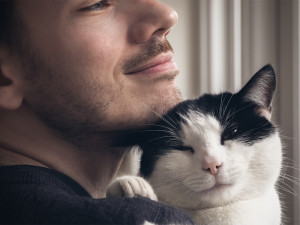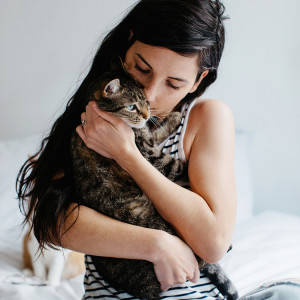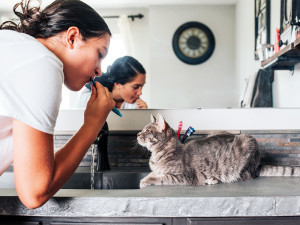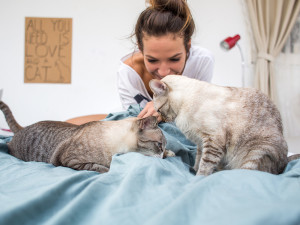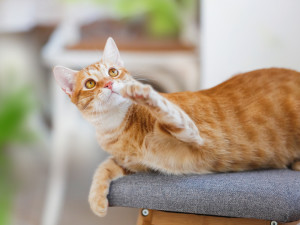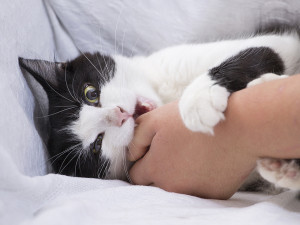Does Your Cat Love You? How to Interpret Bonding Behavior
They tell you in their own way.

Share Article
In This Article:
Does My Cat Love Me? Do Cats Feel Love? Do Cats Love Their Pet Parents? How Do Cats Show Love? How to Make Your Cat Love You
Dogs tend to be pretty obvious with their body language: tails wagging when they’re happy, lowered ears when they’re upset. Cats, however, are a little more subtle, which is why they often get a reputation for being aloof. While a dog will likely greet you at the door (even if you just came back from the mailbox), a cat is more likely to keep their distance. But that doesn’t mean they don’t feel something for you. Right? Do cats love their parents?
“Although cats are wrongfully stereotyped as ‘solitary,’ we know that they can have complex social needs, which includes the capacity to enjoy the company of other animals, including humans,” Dr. Mikel Delgadoopens in new tab, certified cat behavior consultant, says.
So, yes, even when your cat looks at you with what seems like disdain, they still feel some level of affection for you. In fact, if your cat hangs around at all, they likely enjoy being near you; they just have a more subtle way of letting you know.

Does my cat love me?
How do I know if my cat likes me? Cat parents are probably more likely to frantically google their cat’s body language and behavior than dog parents. Let’s face it, canines keep things simple. Part of that comes down to dogs’ longer history of domestication — they’ve adapted to communicate with humans, and we’ve grown to understand their methods of communication.
Cats, on the other hand, are more newly domesticated, and they deign to live in our houses and snuggle up next to us. Understanding the way cats express themselves takes a little more work — and sometimes a lot more patience.
Do cats feel love?
“Cat language” can be challenging to interpret, especially if you haven’t spent much time around cats in the past. Do cats feel love for their owners? Or are they only affectionate when they want their needs met?
Research shows that cats are capable of feeling strong love for their companionsopens in new tab, human and otherwise. They just may not be as expressive as dogs partly because they know how to survive on their own.
“Cats are not obligate social animals because they do not need others to survive,” Dr. Delgado says. “However, that doesn’t mean they can’t form strong bonds. It’s hard to say that they experience love in exactly the same way we do, but they show clear signs of attachment and affection.”
Do cats love their pet parents?
According to some studies, cats view their pet parents in much the same way babies view their own parents. Contrary to their reputation, cats are actually very social and affectionate animalsopens in new tab, and they can grow to love their human parents, as well as other pets in the home. While they may take some time to warm up, an affectionate bond between you and your cat isn’t impossible — but it may take some patience and effort on your part.
How do cats show love?
As humans we tend to be expressive, using a combination of words, tone, body language, and facial expressions to demonstrate our emotions. Cats also use body language to communicate, but they express themselves in subtler (and entirely different) ways.
“Cats are all individuals, and some are more open about showing affection than others,” Dr. Delgado says. “Some obvious signs your cat loves you would be sitting on your lap, rubbing against you, and purring when petting. Other more subtle signs would include spending time in the room with you, sitting near you (if not on you), and soliciting attention by meowing.”
Slow blinking
For a cat, a slow blink, meaning the slow opening and closing of their eyes, is an expression of comfort and a classic sign your cat feels love toward you. You can even return the gesture and slow blink back at your cat to communicate that you love them too.
Purring
A cat’s purr can have multiple meanings, but in many cases, purring means that your cat is happy to be close to you. And if your cat is snuggling up to you and purring at the same time, the only way to interpret that is love (or at least very strong like).
Headbutting
Also known as bunting, cats often gently butt their human parents and each other with their heads. If a cat does this or rubs their cheek against you, they’re putting their scent onto you to demonstrate that you’re part of their family. When a cat rubs up against an object, another animal, or person, their body releases calming pheromones that signal that area or individual is safe — a clear sign of affection and trust.
Sitting on you
Why do my cats like sitting near me? If your cat sits on you or near you, it can be a sign that they love you and find comfort in your presence. Some cats lie on top of their human parents to feel more secure or to express ownership of you. Your cat just might think of you as their pet!
Grooming
Cats groom each other to combine their individual scents and demonstrate trust. The same is true for their human companions, so as uncomfortable as that sandpaper tongue can feel, your cat grooming you is definitely intended as a compliment.
Kneading
Cats knead (sometimes affectionately called “making biscuits”) to show that they’re content and feel relaxed. It’s a behavioral holdover from when they were kittens.
Tail position
Cats use their tails in a variety of ways to communicate their mood. For example, a puffy tail or a tail held low to the body indicates fear or anxiety, while a tail held high expresses confidence and security — and even that your cat is happy to see you.
Following you
Some cats like to follow their human parents from room to room (yes, even into the bathroom). Cats are quick to feel FOMO and want to make sure they’re not missing out on anything their favorite person is doing.
Meowing
While cats often use body language, vocalizing is still a significant part of their communication style. Cats may create their own “meowing language”opens in new tab unique to their human parents; that’s right, they invent their own way of speaking just for you. Your cat may happily chirp or meow when you arrive home or use a more persistent cry when they want your attention.
Showing you their belly
When your cat flops over in front of you and shows you their belly, it’s a clear sign of trust — but not an invitation to pet. A cat showing their belly expresses vulnerability, and they only do this when they love and trust whoever they’re around.
Greeting you
Just like dogs, cats may greet you at the door when you come, just to show you they missed you and are happy to see you again. Your cat may follow up this greeting by walking in between your legs and even curling their tail around you.
Sleeping near you
If your cat chooses to sleep close to you (or on you), it’s a clear sign of love and trust. Even if your cat is just out of reach, their closeness indicates that they feel safe and trust you to protect them — or they want to be nearby to protect you.
How to make your cat love you
Earning a cat’s love and trust can take time, so it’s important to be patient and understand the best ways to encourage your cat’s affection and strengthen your shared bond.
“The best way to encourage your cat to love you is to be kind and gentle with them and to set up the environment to help them feel safe and secure,” Dr. Delgado says. “This means accepting your cat for the individual they are and respecting their preferences for handling and petting. Some cats are very physically affectionate, but most cats prefer to call the shots when it comes to handling. Humans are a high-contact species, whereas cats tend to like brief physical interactions.”
Spend time with your cat.
One of the best ways to show love to your cat is simply to spend time with them. Allow your cat to sit on your lap while you work, read, or watch TV.
Play with your cat often.
Set aside time each day to play with your cat, using ribbon wand toys or interactive toys to keep them physically and mentally stimulated. And make sure to give your cat plenty of ways to entertain themselves when you aren’t home.
“Make sure that your home has lots of vertical spaces for climbing, safe spaces for hiding, a clean litter box, and enough resources (e.g., beds, food dishes, litter boxes), for the number of cats in your home,” Dr. Delgado says.
Allow your cat to be close to you.
Let your cat take the lead and determine how much physical affection and closeness they want from you. If your cat comes up to you for petting, oblige them to encourage them to keep coming back to you for attention and love.
Groom your cat.
Grooming can be an excellent opportunity to bond with your cat. Set aside regular time to brush your cat’s fur. Not only will this strengthen your bond, but it will also help keep your cat’s coat clean and healthy.
Teach your cat tricks (and reward with treats).
Mental stimulation can help reduce stress and keep your cat happy. Indoor cats especially need plenty of enrichment to stay mentally healthy. Try teaching your cat tricks or cues using a clicker — you may be surprised by how readily they take to the challenge.
“Play with your cat with interactive toys daily, give your cat plenty of mental stimulation, and use positive-reinforcement based training methods,” Dr. Delgado says. “If you do these things, you are off to a very good start to making your cat happy, which shows them you love them and also lets them show their best self to you.”
References
“The Inner Life of Cats.” Scientific American, 20 Feb. 2024, www.scientificamerican.com/article/the-inner-life-of-catsopens in new tab.
Vitale, Kristyn R., et al. “Attachment Bonds Between Domestic Cats and Humans.” Current Biology, vol. 29, no. 18, 23 Sept. 2019, pp. R864-R865, www.cell.com/current-biology/fulltext/S0960-9822(19)31086-3?returnURL=http%3A%2F%2Flinkinghub.elsevier.com%2Fretrieve%2Fpii%2Fpii%2FS0960982219310863%3Fshowall%3Dtrue,https://doi.org/10.1016/j.cub.2019.08.036opens in new tab.
Vitulli, William F. “Attitudes Toward Empathy in Domestic Dogs and Cats.” Psychological Reports, vol. 99, no. 3, Dec. 2006, pp. 981-91. https://doi.org/10.2466/pr0.99.3981-991opens in new tab.
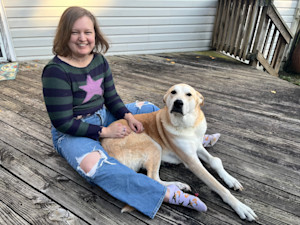
Savannah Admire
Savannah Admire is a writer and pet mom to two dogs and a cat. Under the name Savannah Cooper, she has published poetry in 40 different publications, as well as a poetry book, Mother Viper (2025). When she’s not writing, you can find her reading, taking photos, or volunteering as a content creator for her local community theatre. As a pets writer, she focuses on cat and dog behavior and pet parenthood. She currently lives in Western Maryland.
Related articles
Why Does My Cat Rub His Face on My Face?
You’re gettin’ awfully close there, pal.
Why Does Your Cat Follow You to the Bathroom?
Uh, do you need anything, kitty?
Why Does My Cat Stretch When They See Me?
It’s cute, but what does it mean?
Do Cats Get Jealous? Exploring Feline Emotions and Social Dynamics
Is there a green-eyed monster hiding in that adorable ball of fluff?
![orange cat lifting its paw]()
Why Do Cats Raise a Paw for No Reason?
Are they saying “Hi” or trying to high five? Cat behaviorists decode your pet’s cryptic hand signal.
![cat biting person's hand]()
Why Does My Cat Bite Me?
Don’t live in fear of your feline overlord.

